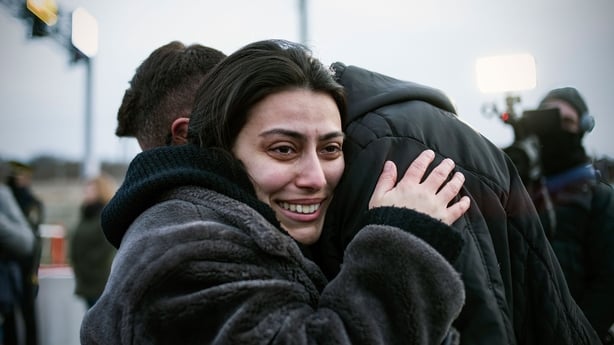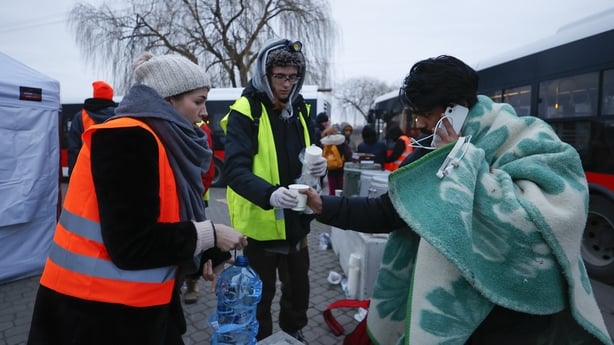Latest update, as of 1pm Irish time
At the Poland/Ukraine crossing at Medyka, there was a lot of activity this morning but few refugees crossing the border.
Aid agencies say it is taking three days for people to cross the frontier, with a tailback on the Ukrainian side estimated to be 15km.
A delegation from the UN's refugee agency, UNHCR, is due to make an assessment of Medyka today. The Irish based aid agency Concern Worldwide was on the ground yesterday.
Polish Humanitarian Action is the lead agency across Poland's 500km border with Ukraine. It is quickly processing refugees and getting them to where they want to go via bus and train - a highly efficient operation.
Poland has accepted nearly half a million refugees from Ukraine in just a week.
The Prime Minister's office said this morning that the total was 474,510 - a fact blamed on "Russian aggression".
The PM Mateusz Morawiecki visited a border check point today with the President of the European Council Charles Michel.
Many are being supported and given accommodation by Ukrainian refugees who fled to Poland in 2014 when Russia invaded and then annexed Crimea.
We need your consent to load this rte-player contentWe use rte-player to manage extra content that can set cookies on your device and collect data about your activity. Please review their details and accept them to load the content.Manage Preferences
However, the concern is that the UN estimates 5 million Ukrainians may become refugees should Russia continue with its invasion.
5km away in Przemyśl, where life usually moves at a slower pace, the quiet town has been completely converted.
It has one of the main radials and a railway link to Lviv in western Ukraine.
Three or four times a day, a train rolls into this town and refugees spill out.
The figures are still something of a moving target but yesterday a Polish minister speaking on radio here said 350,000 Ukrainians had crossed into the country within a couple of hours.
The Chancellery put the figure at 410,000.
What stood out to me over the course of the day, while standing there in the train station was the efficiency of the Polish response.
They get people processed very quickly; they give them some immediate supplies, and then they get them either into some form of accommodation or they put them on trains if people are ready to go and move them elsewhere to places like Warsaw or Kraków where there are even more rail links and try and get them to places across Europe.
For the lucky ones who have family and friends, you can see cars pulling up, people getting out, people being reunited, just outside the train station.

But the greater number are those who have fled Ukraine and have no idea of what is going to happen next.
I met about one woman who was asking me for advice on how she might get to Luxembourg because she had a relative a distant relative there.
But once again while we were having the conversation a Polish volunteer came over to speak to the woman, and was able to assist her immediately.
When the train pulls in from Lviv there is a separate queue.
Once the latest refugees spill out and that disembarkation has been completed, on the three times I was standing outside, there was a second queue and people flowed onto it to get onto the train to return to Ukraine.
Those trains are not going back empty. There is a substantial number of people on those trains, and they are mostly men.
On many occasions they did not want to speak, as they cited fears that if they said they were going back or spoke to us on camera, that this might be a problem for their family.
The train station is about 5km from the actual border, and some people are crossing the border on foot.
There, there is once again an efficient operation, that has been very difficult in previous days just due to the huge volumes.

The Mayor of Poland has been asking people not to go down to the border crossing. They were volunteering to collect refugees who were on foot, bundle them into their car, take them back to the town and try to assist them to get onto the railway, but the volume of people who wanted to help meant that the border crossing was clogging up.
The difficulty is that on the far side of the border crossing, on the Ukrainian side, the tailback is anywhere from 14km to 20km further back, where people are just waiting to cross the border.
And yet despite those flows that I was mentioning, 410,000 so far in a week, a poll published in Poland yesterday showed that there was 90% support for the refugees coming into this country across that 500km of border between Ukraine and Poland.
You can see people spontaneously donating and doing anything that they can.
At an official level, schools are being prepared to admit Ukrainian students, a TV channel being prepared to broadcast in Ukrainian, and a website will be launched by the Polish Chancellery, where citizens can log on to help.
As far as I can see there is a national effort to try and do everything they can, even though the figures are so startling, in which the UN's refugee agency in its latest prediction is saying there could be five million refugees going to flood out of Ukraine in the coming weeks and months.






